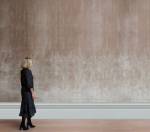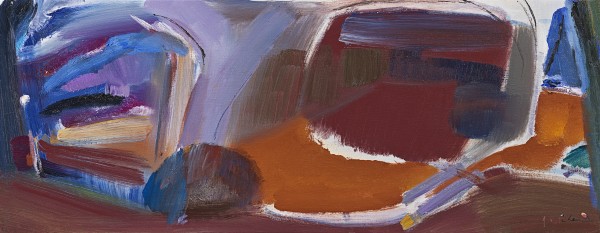Ivon Hitchens
Arched trees - upward and inward movement
Oil on canvas: 16.5 x 43.3 (in) / 41.9 x 109.9 (cm)
Signed lower left: Hitchens; signed and inscribed on the artist’s label attached to the stretcher: "Arched Trees"/"upward and inward movement"/ by Ivon Hitchens / Greenleaves . Petworth . Sussex
This artwork is for sale.
Please contact us on: +44 (0)20 7493 3939.
Email us
IVON HITCHENS
London 1893 - 1979 Petworth
Ref: BX 218
Arched trees - upward and inward movement
Signed lower left: Hitchens; signed and inscribed on the artist’s label attached to the stretcher: "Arched Trees"/"upward and inward movement"/ by Ivon Hitchens / Greenleaves . Petworth . Sussex
Oil on canvas: 16½ x 43¼ in / 41.9 x 109.9 cm
Frame Size: 24½ x 51 in/ 62.2 x 129.5 cm
Painted circa 1954
Provenance:
Private collection
Sotheby’s London, 9th November 1988, lot 125
Bernard Jacobson Gallery, London, IH003;
Private collection, acquired from the above 5th November 1997
In 1954 Ivon Hitchens completed the mural that had been commissioned by the English Folk Dance and Song Society for their headquarters at Cecil Sharp House on the edge of Regent’s Park, London. Measuring 69 x 20 feet, it was at the time the largest mural painting in the country and had involved almost four years’ work. Nevertheless, there was no let-up in the production of new easel-paintings: in this same year, 1954, Hitchens painted some twenty variations on a single motif, Arched Trees, close to where he lived in the woods of West Sussex. The present painting, though unnumbered, belongs with this series and is a classic example of his middle-period woodscapes.
After quickly taking in the mosaic of colour-shapes, the eye is led into the painting, from the pinkish foreground to the brown middle-ground and then to the rectangular patch of green enclosed by thinly brushed burnt sienna. This inward movement is achieved by the flat screens of colour superimposed, one in front of the other, to give a sense of recession. The fresh colours are not muddied with chiaroscuro, nor is there any attempt at illusionistic modelling. As to the upward movement, this is simply created by the thin shapes, leaning slightly off the vertical, which frame the central vista. And in addition to the inward and upward movement there is the horizontal movement of the thin streaks of black, darting from right to left across the canvas, so that the whole picture surface is animated and knit together in one rhythmic whole.
It may seem a pity thus to itemize the components of the scene, like someone who feels the need to name each tree or plant he comes across on a country walk, but Hitchens’ unique pictorial language, however inspired the act of painting, is nothing if not carefully deliberated. Take, for example, the three patches of purple on the right. One, the lightest in tone, teasingly leads out of the picture. The other two point inwards and are picked up by the leftward-trending purples on the left. Similarly, the tall, triangular blue on the left answers the long, tilting black on the right. Every brushstroke and colour patch contributes in some way to articulate the whole.
It is this pictorial science underlying the composition of each of his paintings that supports Hitchens’ claim to be essentially an abstract painter. The motif itself is of no intrinsic importance: it merely provides the starting point for a series of interpretations, each one ideally a self-existent solution of the problem posed by the infinitely complex visual data.
Peter Khoroche
Ivon Hitchens, Study for the mural painting at Cecil Sharp House, London, c. 1950, Tate
Ivon Hitchens, Arched Trees no.2, late summer
Oil on canvas: 50.2 x 104.9 cm
Portsmouth Museums
Ivon Hitchens, Arches Trees no.7, 1957 Ivon Hitchens, Arched Trees no.12, 1954
Oil on canvas: 41 x 86.4 cm Oil on canvas: 46 x 109.5 cm
Southampton City Art Gallery National Museum Wales, Cardiff
IVON HITCHENS CBE
London 1893 –1979 Petworth
Sydney Ivon Hitchens was the only child of artist Alfred Hitchens and Ethel Margaret Seth-Smith, a talented amateur artist. Following his early education at Conamur School, Sandgate, Kent, Hitchens attended Bedales School, Hampshire from 1903 until acute appendicitis cut short his school days and sent him on a recuperative voyage to New Zealand. Hitchens’ art education began at St John’s Wood School of Art, London from 1911 and continued at the Royal Academy Schools from 1912-16. He returned to the RA Schools between 1918-19, following two years’ service in hospital supply during the First World War. Still not fully recovered from his youthful illness, Hitchens was declared unfit for active service in 1916.
After graduating from the RA Schools, Hitchens moved into a studio at 169 Adelaide Road, Hampstead in 1919 and later became part of a circle of avant-garde British artists including Barbara Hepworth, Henry Moore, Paul Nash and Ben Nicholson living in Hampstead in the 1930s. In 1920 he exhibited at the first exhibition of the Seven & Five Society, becoming a member that same year. Hitchens was elected a member of the London Artists’ Association in 1929, of the London Group in 1931 and of the Society of Mural Painters in 1937. The artist exhibited with the Leicester Galleries from 1940 until 1960, when he moved to the Waddington Galleries.
Hitchens married Mary Cranford Coates on 27th June 1935. He and his wife left London in 1940 with their only child, John, for a caravan at Greenleaves, Lavington Common near Petworth, Sussex, after a bomb landed next door to his Hampstead studio. For the next forty years, Hitchens’ six acres of woodland near Midhurst became his home, place of study and constant source of inspiration.
In 1951 the artist won a purchase prize at the Festival of Britain exhibition, 60 paintings for ‘51. Hitchens completed a mural at Cecil Sharp House, Regent’s Park Road in 1954, and installed another mural at the University of Sussex in 1962. In 1956 the British Council arranged a retrospective exhibition of his work for the Venice Biennale. In 1957 Hitchens was created CBE. A major retrospective of Hitchens’ work was arranged by the Arts Council at the Tate Gallery, London in 1963. In 1979 a third retrospective exhibition was held at the RA Diploma Galleries.





























